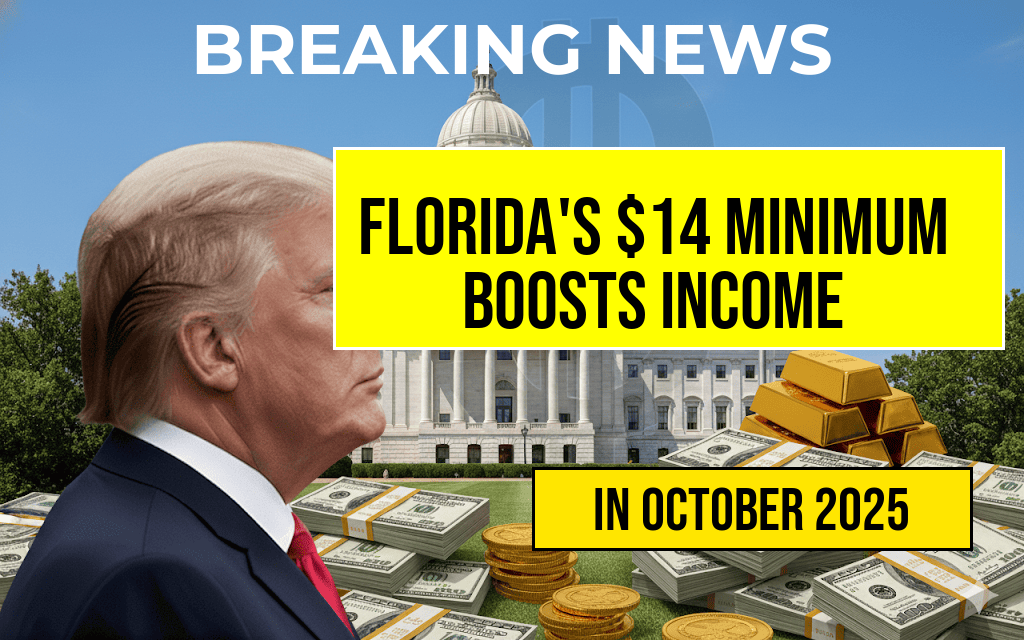Florida’s recent increase in the minimum wage to $14 per hour marks a significant shift for the state’s workforce, particularly for full-time employees. Effective from September 30, 2023, this adjustment is projected to boost the annual income of full-time workers by approximately $2,080, based on a standard 40-hour workweek. This change reflects Florida’s ongoing efforts to align wages with the rising cost of living and aims to provide greater financial stability for low- and middle-income earners across the state.
Under the new legislation, Florida’s minimum wage has increased from $11.25 to $14 per hour, a move that surpasses the federal minimum wage of $7.25. The increase is part of a scheduled phased approach, with the next target set for 2024 when the minimum wage is expected to rise again to $15. Advocates for the raise argue that this adjustment will help address wage stagnation and improve economic well-being for thousands of workers in sectors such as retail, hospitality, and healthcare.
Impact on Workers and Employers
Financial Gains for Full-Time Employees
| Previous Hourly Wage | New Hourly Wage | Annual Income Increase |
|---|---|---|
| $11.25 | $14.00 | $2,080 |
Assuming a standard 40-hour workweek, the annual income increase for full-time workers earning the minimum wage will amount to roughly $2,080. This calculation considers 52 weeks of work, excluding unpaid time off. The added income could provide more room for savings, debt repayment, or discretionary spending, potentially stimulating local economies across the state.
Business Perspectives and Challenges
While many workers welcome the increase, business owners, especially small enterprises, express concerns about higher labor costs. Some argue that the wage boost could lead to increased prices for consumers or reduced hiring. However, industry groups such as the Florida Retail Federation emphasize the importance of fair wages in attracting and retaining staff, which can ultimately benefit overall customer service and business stability.
Broader Economic Context
Comparison with National Trends
Florida’s move aligns with a national trend toward higher minimum wages, with over 30 states implementing or planning to implement wage increases in recent years. States like California and New York have set their minimum wages well above the federal level, emphasizing the growing momentum for wage reforms to address income inequality.
Cost of Living Adjustments
Florida’s rising minimum wage is also a response to increasing living expenses. Housing costs, healthcare, and transportation have all seen substantial hikes, making it challenging for low-income workers to meet basic needs. According to data from the U.S. Bureau of Labor Statistics, inflation has contributed to a decline in real wages nationwide, prompting policymakers to pursue targeted wage hikes like Florida’s.
Future Outlook and Policy Debates
Next Steps and Legislative Developments
Florida’s minimum wage is scheduled to reach $15 per hour by September 2024, an increase that is expected to further elevate earnings for full-time workers. This phased approach aims to mitigate potential economic disruptions while gradually improving worker compensation. Discussions continue regarding the potential for future increases beyond 2024, with some advocates pushing for a living wage standard that reflects the true costs of living in Florida’s diverse regions.
Economic Studies and Impact Assessments
Research from organizations such as the Economic Policy Institute suggests that modest wage increases tend to have limited negative effects on employment levels, particularly in low-wage sectors. Instead, they can lead to higher productivity and reduced turnover, benefiting both workers and employers over time.
Summary
The increase to a $14 minimum wage in Florida signifies a meaningful step toward improving income security for full-time workers. With an estimated annual earnings boost of $2,080, many employees may find greater financial flexibility. While some business owners express concerns about rising costs, policymakers and economic analysts maintain that fair wages are essential for sustainable economic growth and reducing income disparities. As Florida continues to phase in higher wages, the evolving landscape will likely influence broader debates about affordable living standards and workforce stability across the state.
Frequently Asked Questions
What is the new minimum wage in Florida?
The new minimum wage in Florida has increased to $14 per hour, effective immediately, providing a boost to workers across the state.
How does the wage increase affect full-time workers’ annual income?
For full-time workers earning the new minimum wage, the increase results in an additional $2,080 annually, significantly improving their overall earnings.
When did Florida implement the new minimum wage?
Florida’s minimum wage was officially raised to $14 per hour as part of the state’s scheduled annual adjustment, effective from the start of the year.
Who benefits from Florida’s minimum wage increase?
This wage boost primarily benefits full-time workers earning the minimum wage, helping them afford increased living costs and improving their financial stability.
Are there plans for further minimum wage increases in Florida?
Florida’s minimum wage is set to increase annually based on inflation and cost of living adjustments, with ongoing efforts to ensure fair wages for workers.




